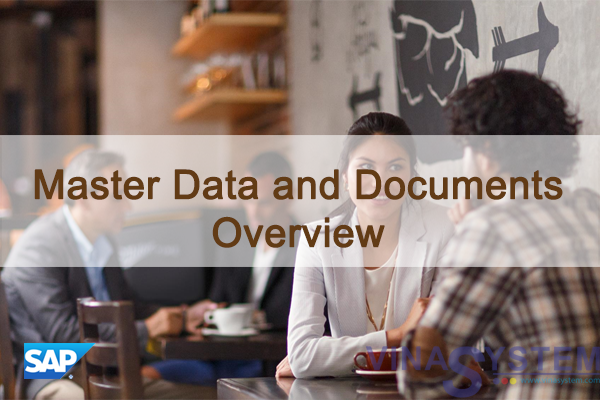
Tổng quan về dữ liệu và tài liệu trong SAP Business One (MasterData & Document)
At the end of this topic, you will be able to:
- View a customer record
- Explain the concept of master data
- Create and change a document
I/ Master Data Concept

SAP Business One tracks business activities using documents such as purchase orders, invoices, production orders, sales orders, and so on.
Each of these documents is constructed from smaller reusable chunks of data called master data.
Master data refers to the key information that describes your customers, vendors, and leads as well as items that your company buys and sells.
Creating documents from master data increases productivity, ensures data consistency, and reduces errors.
3 Types of Business Partners

There are three types of business partners used in purchasing and sales documents: leads, customers and vendors.
Leads are used in the sales process to represent sales prospects.
Once a sale is made, you can convert a lead to a customer.
Vendors are used in the purchasing process.
Each lead, customer or vendor is represented in SAP Business One by a business partner master data record.
One transaction is used to access all three types of business partners. However, the forms for each type differ slightly so that they can hold the appropriate data for each.
II/ Finding Master Data

It is easy to look up business partner and item information while you are entering sales and purchasing documents. A selection list icon is available in the business partner and item number fields in marketing documents.
The selection list icon is invisible until you click into a field. When you click into the field, the field highlights and the icon appears.
Use the selection list icon to make a selection list open.
You can scroll through the list or use characters with wildcards to search.
III/ Configuration Data

Some of the information that appears in master data comes from configuration.
For example, payment terms are set up in advance of setting up customers.
Choosing the link arrow in the business partner window for payment terms, I can navigate to the configuration data.
Some fields with a dropdown menu such as the payment terms, will let authorized users define new options if there are none appropriate. This type of direct configuration is typical in SAP Business One.
The purpose of configuration data and master data is to make creating documents for business transactions easier. Now let us look at how we create documents to capture the information about a business activity in sales or purchasing.
IV/ Marketing Documents

All the documents in purchasing and in sales share a similar structure. The documents for sales and purchasing are also often called “Marketing Documents”.
In general the document is divided into:
- The upper part (header) with the general information,
- The middle part with the information on different tab pages and the item specific data,
- And the lower part (footer) with more general information.
The middle part contains 4 tabs:
- The Contents tab is where all the specific information about the ordered items or services is entered, such as quantity, price, item number, and description. You can access more item specific data in the line details by double-clicking a row.
- The Logistics tab contains the details about where the items or services and payments are to be sent. Shipping method is also specified here. Most of the data is pulled from preconfigured master company details and vendor data.
- The Accounting tab contains the relevant general ledger (G/L) account information for the purchase pulled from the financial accounting master data.
- The Attachments tab allows you attach supplementary files to your documents.
- Much of the data appearing in these tabs defaults from the master data. The values can be changed while working in the documents. These changes will affect the document, but do not change the master data records.
V/ Row Type in Marketing Documents

In marketing documents, you can choose the row’s type on the Contents tab page.
The default view of the system is without the type column, but you can add easily add it in the Form Settings window. Form Settings are available for windows in SAP Business One and control the visibility of optional fields.
The options for the row types are:
- Blank: for a regular item row this field is empty
- T: for a text row
- S: for a subtotal row
- A: If the document is a sales quotation, the option A is available for an alternative item row. An alternative item is not taken into account on sum calculations. When the document is copied to a target document, a user can decide if the alternative item should remain or be deleted.
You can change the format of any row in the Contents tab of any SAP Business One purchasing document to insert text or a subtotal of the preceding row. Simply click on the drop-down list in the Type field and select T (for text) or S (for subtotal). When you select T, the Text Editor pop-up window appears. From here, insert predefined text from the drop-down list or insert your own text. This is especially helpful when you want to convey specific instructions to your vendor about how items should be manufactured, handled, or shipped.
VI/ Draft Documents

You can save most documents as a draft in SAP Business One. This lets you make changes or enter missing information before adding them to the database as regular documents.
For example, perhaps you check some information before offering a particular discount to a customer in a sales quotation. You can create the document, enter the items the customer wishes to purchase along with the discount, then save a draft of the sales quotation.
Document drafts can also be used as templates for documents you frequently create.
You can display a list of draft documents. Using selection criteria, you can find and process specific documents. When you open a draft document, you can make any needed changes and then add the document as a regular document to the database.
VII/ Creating related documents

When doing business you often have a need to copy information from one document to another. For example, you have created a sales quotation for a customer and now you would like to create a sales order from the quotation.
In these cases you can easily copy the sales quotation to a sales order.
VIII/ Relationship Map

Once you create a related document, you can view the relationship between documents. One way is to use the relationship map.
In the graphic, the user has opened the relationship map from a delivery. The delivery is yellow because it is the entry point to the relationship map.
This delivery is based on a sales order which was based on a sales quotation. The closing point for this chain, in this case, is an incoming payment.
From the relationship map, you can double-click on any icon to open a document within the chain to see the document details, addresses, payment terms and so on.
Different views can be selected in the selection box. You can view the documents, related journal entry postings, or items from the rows of the documents.
IX/ Reference an unrelated document

You also have the option to create a relationship in the relationship map by referencing an unrelated document.
For example, you create a credit memo to refund a customer for a item that breaks after they’ve paid for it. Because the credit memo was not made as a follow-on document to the invoice, there is no relationship appearing in the relationship map. Later you would like to link the two documents so it is clear why the credit was paid. In this case, you can use the Reference Document button on the Accounting tab of either document.
This opens the Reference Information window where you can choose an existing document to reference.
In the Relationship Map, choose Referenced Documents in the dropdown to view the relationship you have created.
X/ Drag & Relate

Drag&Relate is a particularly effective means of linking two business objects to create a query.
The screen on the right shows the data in an item master record. If you want to find out which quotations have been made for this item, for example, you simply drag the Item Number field to the Quotations entry in the navigation Drag&Relate tree. The system then displays a list of all the quotations for the item. If this list is too long, you can filter the list to display just the results that you are interested in.
You can limit the authorizations per user for using the reports in the general authorizations transaction in the Administration menu.
XI/ Summary
Here are some key points to remember:
- Creating documents from master data increases productivity, ensures data consistency, and reduces errors
- The three types of business partner master data are vendor, lead and customer.
- Marketing documents share a common structure.
- Marketing documents can be saved as drafts.
- You can easily copy the information in one marketing document to another. Copied documents are linked and their connections can be viewed in a relationship map.
- Drag and Relate is a quick way to create ad hoc reports.






